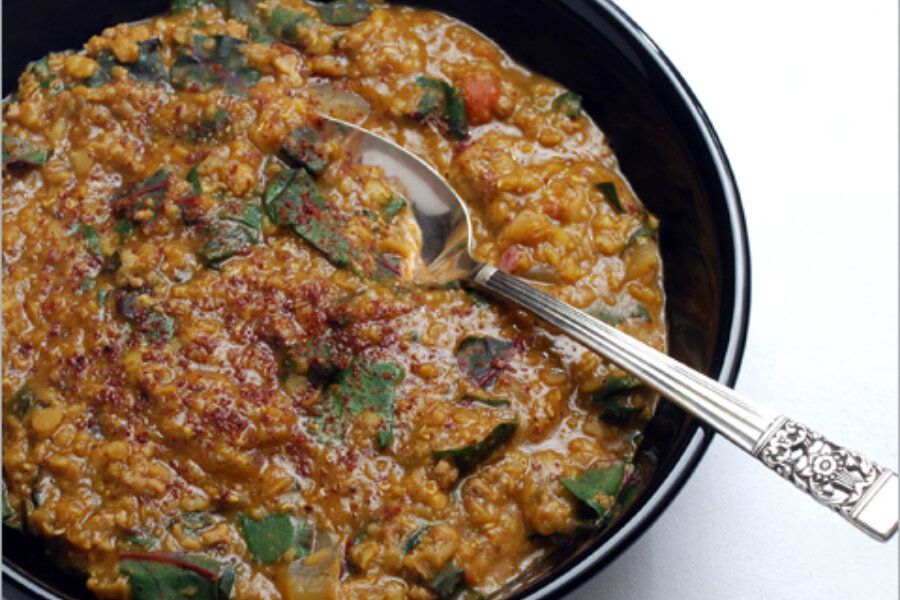By Marion Nowak, Blue Kitchen
Serves 8
1/2 pound ground lamb (see Kitchen Notes)
2 tablespoons olive oil
1 tablespoon garlic, coarsely chopped
3/4 cup onions, coarsely chopped
2 tablespoons paprika
1 10 to 12 ounce can diced tomatoes with jalapeños (see Kitchen Notes)
2 cups dried red lentils [see Kitchen Notes]
5 tablespoons white rice
4 cups water
2 cups stock (chicken or vegetable)
1/8 teaspoon cayenne
1 teaspoon black pepper
1 tablespoon sumac plus 1/2 teaspoon per bowl for garnish
1/2 pound chard, center rib removed, cut into small pieces (see Kitchen Notes)
1. Put 1/2 tablespoon olive oil in a sauté pan and heat the pan. Brown the lamb, then drain it on paper towels or in a sieve over a bowl. Discard the drippings.
2. Rinse the lentils and pick them over to make sure there aren’t any tiny stones in the mix.
3. Put the rest of the olive oil in a deep, heavy pot and heat it to medium. Add the onions and garlic and sauté for a couple of minutes, until the onion is translucent and limp. Lower the flame, then add the paprika all at once and stir into the oil – stir and sauté the mix for a couple of minutes. Then add in the lentils, stir everything, and add the stock and water and stir again.
4. Stir in the rice, canned tomatoes, cayenne, and black pepper. Bring the pot to a boil and reduce the heat to a simmer. Add in half the lamb at this point. Let everything simmer and kind of keep an eye on it, stirring to make sure it does not stick and does not need more liquid.
5. The lentils should be cooked through after about 35 to 40 minutes. At this point, turn off the heat. Take out about a third of the soup and blend it smooth, then return to the pot. Add the rest of the lamb and reheat the soup. When it is simmering, stir in the 1 tablespoon of sumac and then the chard. It will look like way, way too much chard for the volume of soup. Don’t be alarmed—as it cooks, it quickly shrinks down to a cooperative size. When the chard is deep green and cooked, the soup is ready to serve. Serve in individual bowls, garnished with a scattering of sumac.
Kitchen Notes
Lamb – varieties and possible substitutes. This version calls for ground lamb, but I’ve also made it using meaty lamb bones we had in the freezer that were left over from another dinner. There was less actual meat involved with that version, but a stronger lamby flavor. You could also use a stew cut of lamb, or you could go for goat, another kind of meat used in Mediterranean and Middle Eastern cooking. You could even use pork – it wouldn’t have the authentic Turkish flavor, but it would be very good. The idea is to use meat, but just a modest amount of it, as more of a flavoring than the centerpiece. For that matter, you may omit meat entirely from this. It won’t be the same, but it will be different.
Tomatoes and heat. If you don’t have canned tomato with jalapeño (such as RO-TEL), substitute plain canned tomato and add a little more cayenne or a little jalapeño. If you really don’t want any hot peppers at all, you can omit them entirely.
What color is your lentil? There are many kinds of lentils, each with its own variation on the basic earthy flavor. This recipe calls for red lentils, which I chose for the pretty color and their lighter nutty taste. (Note that red lentils happen to be lower in fiber than other varieties.) Brown lentils, the everyday variety that is most widely available in North America, would be terrific in this recipe.
Cutting the chard. Cut the chard into pieces the size you would like to eat with a spoon – that is, no snaky ribbons or huge sheets.
Read the full post on Stir It Up!








